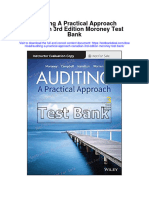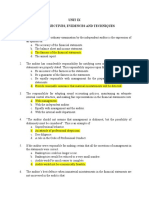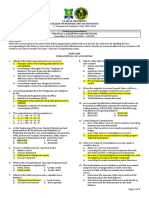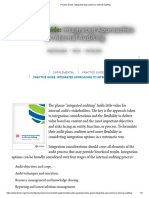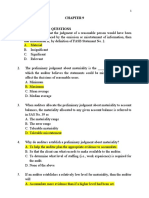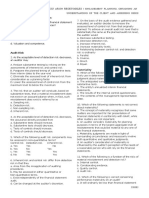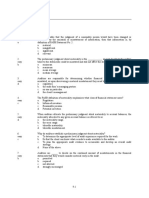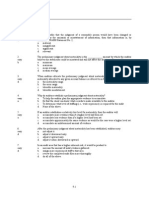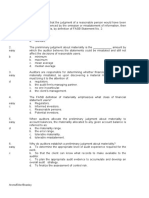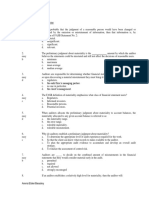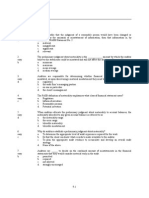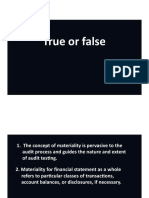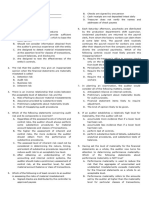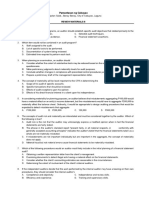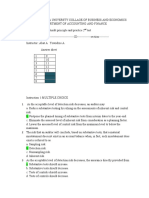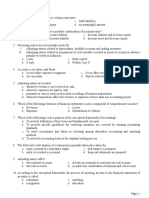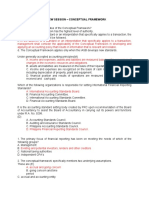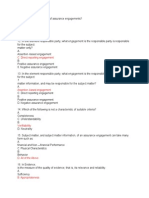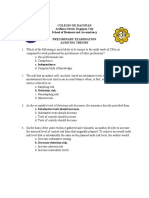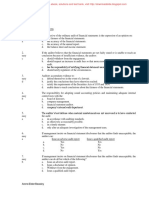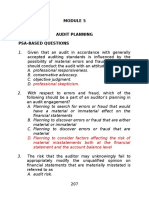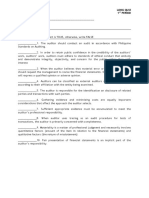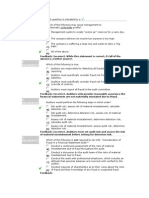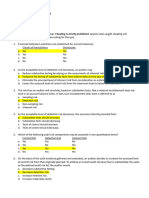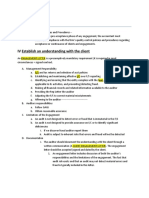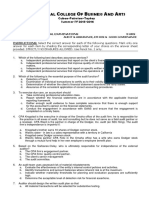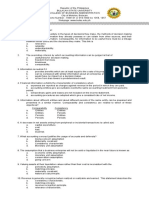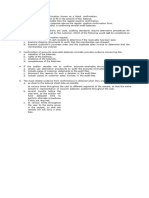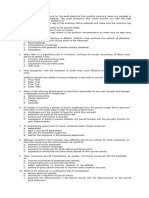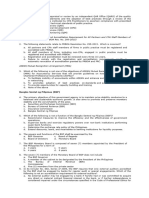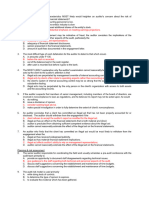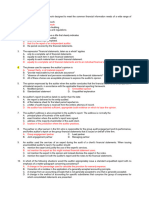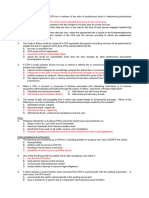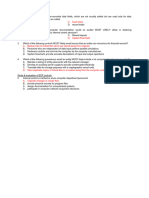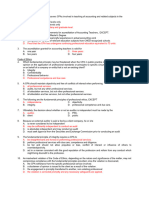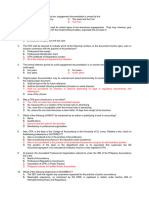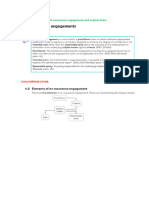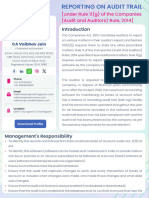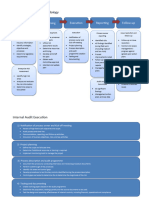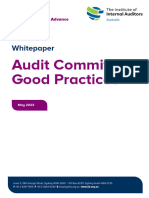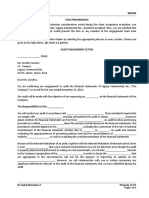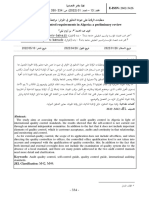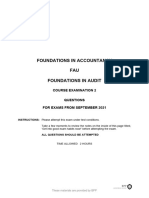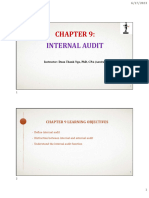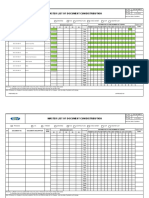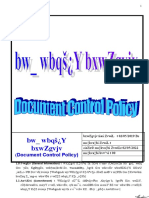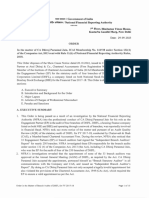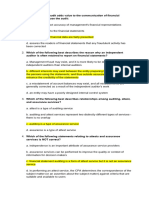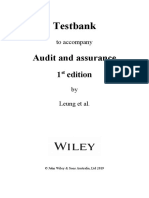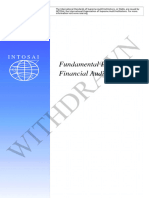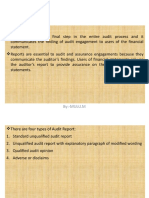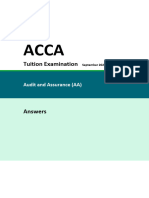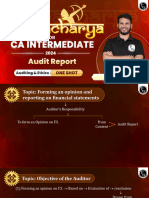Audit 8
Audit 8
Uploaded by
batistillenieCopyright:
Available Formats
Audit 8
Audit 8
Uploaded by
batistillenieOriginal Title
Copyright
Available Formats
Share this document
Did you find this document useful?
Is this content inappropriate?
Copyright:
Available Formats
Audit 8
Audit 8
Uploaded by
batistillenieCopyright:
Available Formats
1.
Inherent risk and control risk collectively are known as the
A. dependent variables of risk C. risk of information dissemination
B. dual risk team D. risk of material misstatement
2. Inherent risk and control risk differ from detection risk in that inherent risk and control risk are
A elements of audit risk white detection risk is not.
B. changed at the auditor's discretion while detection risk is not.
C. functions of the client and its environment while detection risk is not.
D. considered at the individual account-balance level while detection risk is not.
3. What are the different levels of risk assessment?
A. "High" and "Low". C. "High" and "Less than High".
B. "Higher" and "Lower". D. ''Maximum" and "Minimum".
4. The acceptable level of detection risk (ADR) and the combined level of inherent risk (IR) and control risk (CR)
are ________ related.
A. directly C. not
B. inversely D. proportionately
5. Inherent risk is reduced when the likelihood of defalcations is low. This would be true for an account such as
A. Accounts receivable. C. Held for trading securities.
B. Cash. D. Property, plant and equipment.
6. When setting a preliminary judgment about materiality
A. there is no relationship between it and the peso amount of evidence needed.
B. the same amount of evidence is required for either low or high peso amounts.
C. less evidence is required for a low peso amount than for a high peso amount.
D. more evidence is required for a low peso amount than for a high peso amount.
7. When the auditors allocate the preliminary judgment about materiality to account balances, the materiality
allocated to any given account balance is referred to as
A. The error range. C. Tolerable materiality.
B. The materiality range. D. Tolerable misstatement.
8. In considering materiality for planning purposes, an auditor believes that misstatements aggregating P 10,000
would have a material effect on an entity's profit, but that misstatements would have to aggregate P 20,000 to
materially affect the statement of financial position. Ordinarily, it would be appropriate to design auditing
procedures that would be expected to detect misstatements that aggregate
A. P 10.000 C. P 20,000
B. P 15,000 D. P 30,000
9. Regardless of how the allocation of the preliminary judgment about materiality was done, when the audit is
complete the auditor must be confident that the combined errors in all accounts are
A. Equal to the preliminary judgment.
B. Less than the preliminary judgment.
C. More than the preliminary judgment.
D. Less than or equal to the preliminary judgment.
10. After beginning an audit of a new client, Syd, CPA, discovers that the professional competence necessary for
theengagement is lacking. Sydney informs management of the situation and recommends another CPA, and
managementengages the other CPA. Under these circumstances
A. Syd's lack of competence should be considered to be a violation of generally accepted auditingstandards.
B. Syd may request compensation from the client for any professional services rendered to it inconnection
with the audit.
C. Syd's request for a commission from the other CPA is permitted because a more competent audit cannow
be performed.
D. Syd may be indebted to the other CPA since the other CPA can collect from the client only the amountthe
client originally agreed to pay Syd.
You might also like
- Auditing Theory by Wiley Testbank 1Document87 pagesAuditing Theory by Wiley Testbank 1Liam Jacque LapuzNo ratings yet
- ACA - Assurance - Electronic Question BankDocument108 pagesACA - Assurance - Electronic Question BankĐặng Diễm Ngọc100% (1)
- Auditing A Practical Approach Canadian 3Rd Edition Moroney Test Bank Full Chapter PDFDocument56 pagesAuditing A Practical Approach Canadian 3Rd Edition Moroney Test Bank Full Chapter PDFmantillagreedilyjxsb100% (17)
- CFP Certification Exam Practice Question Workbook: 1,000 Comprehensive Practice Questions (2019 Edition)From EverandCFP Certification Exam Practice Question Workbook: 1,000 Comprehensive Practice Questions (2019 Edition)Rating: 5 out of 5 stars5/5 (1)
- Audit Objectives, Evidences and Techniques - 50 PagesDocument53 pagesAudit Objectives, Evidences and Techniques - 50 PagesPam G.100% (2)
- 2018A QE Financial Accounting and Reporting FinalDocument6 pages2018A QE Financial Accounting and Reporting FinalJoy Dhemple Lambaco50% (2)
- Practice Guide - Integrated Approaches To Internal AuditingDocument3 pagesPractice Guide - Integrated Approaches To Internal AuditingOnnNo ratings yet
- Internal Control/Anti-Fraud Program Design for the Small Business: A Guide for Companies NOT Subject to the Sarbanes-Oxley ActFrom EverandInternal Control/Anti-Fraud Program Design for the Small Business: A Guide for Companies NOT Subject to the Sarbanes-Oxley ActRating: 4 out of 5 stars4/5 (1)
- CHAP 9. Materiality and RiskDocument28 pagesCHAP 9. Materiality and RiskNoroNo ratings yet
- Multiple-Choice QuestionsDocument75 pagesMultiple-Choice QuestionsJasmine LimNo ratings yet
- 3 Review RecDocument8 pages3 Review RecJobelle Candace Flores AbreraNo ratings yet
- Multiple-Choice QuestionsDocument9 pagesMultiple-Choice QuestionsjhouvanNo ratings yet
- Chapter 09 MaterialityDocument26 pagesChapter 09 MaterialityNej ElocinNo ratings yet
- T.B - CH09Document17 pagesT.B - CH09MohammadYaqoob100% (1)
- AC316 CH 9 MCDocument20 pagesAC316 CH 9 MCNanon WiwatwongthornNo ratings yet
- Chapter 9 FinalDocument17 pagesChapter 9 FinalMichael Hu33% (3)
- Review Questions Unit BDocument17 pagesReview Questions Unit BAnna TaylorNo ratings yet
- Multiple-Choice QuestionsDocument17 pagesMultiple-Choice QuestionsathenaNo ratings yet
- Multiple-Choice QuestionsDocument17 pagesMultiple-Choice Questionsdimas prastowoNo ratings yet
- Chapter9 - FinalDocument17 pagesChapter9 - FinalbraveusmanNo ratings yet
- QuesDocument3 pagesQuesA. MagnoNo ratings yet
- Aud TheoDocument38 pagesAud TheoAtaii Ckaa Ü LolzNo ratings yet
- Aud Practice Set 2Document5 pagesAud Practice Set 2Jessica RodrigoNo ratings yet
- 60D10731 2Document12 pages60D10731 2Meryl BaytecNo ratings yet
- Audit Theory - Booklet 2Document39 pagesAudit Theory - Booklet 2Charis Marie UrgelNo ratings yet
- Accounting 151 - FINAL EXAMINATIONDocument8 pagesAccounting 151 - FINAL EXAMINATIONMohammad Muariff BalangNo ratings yet
- Review Materials LLDocument12 pagesReview Materials LLFake AccountNo ratings yet
- At 3rd Evals ExamDocument12 pagesAt 3rd Evals ExamJohn Remy SamsonNo ratings yet
- Audit 2 Test About MaterilaityDocument5 pagesAudit 2 Test About MaterilaityShewanes GetiyeNo ratings yet
- Auditing Quiz BeeDocument9 pagesAuditing Quiz BeeWilsonNo ratings yet
- Excel Professional Services, Inc.: Discussion QuestionsDocument5 pagesExcel Professional Services, Inc.: Discussion QuestionsSadAccountantNo ratings yet
- Bsa SM 1 1 Set ADocument10 pagesBsa SM 1 1 Set ARicaRhayaMangahasNo ratings yet
- Review Session 3 Conceptual FrameworkDocument16 pagesReview Session 3 Conceptual Frameworkalyanna alanoNo ratings yet
- C6 and C7 - Auditing TheoryDocument8 pagesC6 and C7 - Auditing TheoryErica LopezNo ratings yet
- QuizDocument26 pagesQuizJan YasaNo ratings yet
- Week2 Discussion AnswersDocument15 pagesWeek2 Discussion AnswersCha BuenaventuraNo ratings yet
- CHAPTER 7 Auditing-Theory-MCQs-by-Salosagcol-with-answersDocument2 pagesCHAPTER 7 Auditing-Theory-MCQs-by-Salosagcol-with-answersMichNo ratings yet
- Colegio de Dagupan Arellano Street, Dagupan City School of Business and Accountancy Preliminary Examination Auditing TheoryDocument18 pagesColegio de Dagupan Arellano Street, Dagupan City School of Business and Accountancy Preliminary Examination Auditing TheoryFeelingerang MAYoraNo ratings yet
- At-5909 Risk AssessmentDocument8 pagesAt-5909 Risk AssessmentVeron BrionesNo ratings yet
- Multiple-Choice QuestionsDocument20 pagesMultiple-Choice QuestionsRafael GarciaNo ratings yet
- 5 Audit PlanningDocument53 pages5 Audit PlanningrogealynNo ratings yet
- Identify The Choice That Best Completes The Statement or Answers The QuestionDocument13 pagesIdentify The Choice That Best Completes The Statement or Answers The QuestionMarielle Mae BurbosNo ratings yet
- C. Both Statements Are FalseDocument12 pagesC. Both Statements Are FalseShaira Bagunas ObiasNo ratings yet
- Acc 139 Long QuizDocument6 pagesAcc 139 Long QuizJhoylie Besin-NobleNo ratings yet
- CH 4 QuizDocument4 pagesCH 4 Quizwsvivi100% (1)
- Conceptual Framework For Financial Reporting: QuizDocument4 pagesConceptual Framework For Financial Reporting: QuizWenjunNo ratings yet
- Test Bank-Auditing Theory Chapter 9Document6 pagesTest Bank-Auditing Theory Chapter 9Michael CarlayNo ratings yet
- MidtermDocument9 pagesMidtermSohfia Jesse VergaraNo ratings yet
- Chapter 08 Audit PlanningDocument23 pagesChapter 08 Audit PlanningNej ElocinNo ratings yet
- Audcis Quiz 1Document4 pagesAudcis Quiz 1alexissosing.cpaNo ratings yet
- Auditing II Test BankDocument68 pagesAuditing II Test Bankm992727379No ratings yet
- Review - Chapter 3 & 4 (E.Q)Document21 pagesReview - Chapter 3 & 4 (E.Q)050610220695No ratings yet
- A3 - Topic 1Document7 pagesA3 - Topic 1jgames777No ratings yet
- N C O B A A: Ational Ollege F Usiness ND RTSDocument9 pagesN C O B A A: Ational Ollege F Usiness ND RTSNico evansNo ratings yet
- Practice Examination II. Questions.Document6 pagesPractice Examination II. Questions.Twinie MendozaNo ratings yet
- Acctg QuizDocument6 pagesAcctg Quizelaine olivaNo ratings yet
- FPQP Practice Question Workbook: 1,000 Comprehensive Practice Questions (2024 Edition)From EverandFPQP Practice Question Workbook: 1,000 Comprehensive Practice Questions (2024 Edition)No ratings yet
- CISA Exam-Testing Concept-Knowledge of Risk AssessmentFrom EverandCISA Exam-Testing Concept-Knowledge of Risk AssessmentRating: 2.5 out of 5 stars2.5/5 (4)
- From Bad to Good Credit: A Practical Guide for Individuals with Charge-Offs and CollectionsFrom EverandFrom Bad to Good Credit: A Practical Guide for Individuals with Charge-Offs and CollectionsNo ratings yet
- Internal Control of Fixed Assets: A Controller and Auditor's GuideFrom EverandInternal Control of Fixed Assets: A Controller and Auditor's GuideRating: 4 out of 5 stars4/5 (1)
- Apa 6Document1 pageApa 6batistillenieNo ratings yet
- Aap 6Document2 pagesAap 6batistillenieNo ratings yet
- Poa 8Document2 pagesPoa 8batistillenieNo ratings yet
- Audit 7Document2 pagesAudit 7batistillenieNo ratings yet
- Audit 22Document1 pageAudit 22batistillenieNo ratings yet
- Audit 6Document2 pagesAudit 6batistillenieNo ratings yet
- Audit 19Document1 pageAudit 19batistillenieNo ratings yet
- Audit 5Document1 pageAudit 5batistillenieNo ratings yet
- Audit 4Document2 pagesAudit 4batistillenieNo ratings yet
- BPP AuditDocument29 pagesBPP Auditlamiyasamandarzada1No ratings yet
- Reporting On Audit Trail - 2024Document9 pagesReporting On Audit Trail - 2024Ajay UpadhyayNo ratings yet
- Internal Audit MethodologyDocument4 pagesInternal Audit Methodologyrogue.xnxNo ratings yet
- Audit Committee Good Practices 1683810157Document9 pagesAudit Committee Good Practices 1683810157Fabiha RizviNo ratings yet
- 06 Task Performance 1 PDFDocument3 pages06 Task Performance 1 PDFFritch SolisNo ratings yet
- متطلبات الرقابة على جودة التدقيق في الجزائر - مراجعة أوليةDocument17 pagesمتطلبات الرقابة على جودة التدقيق في الجزائر - مراجعة أوليةNoureddine MezianiNo ratings yet
- Fau Mock 2Document12 pagesFau Mock 2tshepomoejanejrNo ratings yet
- Slides - Chapter 9Document7 pagesSlides - Chapter 9Thu TrangNo ratings yet
- SKV-FM-MR-03 Record Control Master List Filled For QADocument14 pagesSKV-FM-MR-03 Record Control Master List Filled For QASaurabh BhadouriyaNo ratings yet
- Cost Auditing Standard - 101 Cost Auditing Standard On Planning An Audit of Cost StatementsDocument8 pagesCost Auditing Standard - 101 Cost Auditing Standard On Planning An Audit of Cost Statementsks_cma9051No ratings yet
- Document Control PolicyDocument10 pagesDocument Control PolicyEast WestNo ratings yet
- DHFL NfraDocument15 pagesDHFL NfraExplore HimalayaNo ratings yet
- Audit Principles QuizDocument9 pagesAudit Principles QuizCindy BitongNo ratings yet
- Risk-Based Audit Best PracticesDocument7 pagesRisk-Based Audit Best PracticesGerman ChavezNo ratings yet
- Ch10 TB Leung 1eDocument14 pagesCh10 TB Leung 1eshelyn chandNo ratings yet
- Acctg 22 Preliminary Examination Set CDocument44 pagesAcctg 22 Preliminary Examination Set CheeeyjanengNo ratings yet
- CMA Inter Auditing Reivison Notes by CocDocument31 pagesCMA Inter Auditing Reivison Notes by CocchakrabortydipanjantintinNo ratings yet
- ContinueDocument5 pagesContinueChintuNo ratings yet
- Issai 200Document41 pagesIssai 200ateam4984No ratings yet
- Chapter 3Document38 pagesChapter 3Tony amador gonzalezNo ratings yet
- Bact 311 Course Outline Sept 2022Document4 pagesBact 311 Course Outline Sept 2022Pa HabbakukNo ratings yet
- Chapter Six Audit Reports: By:-MULU.MDocument17 pagesChapter Six Audit Reports: By:-MULU.MYehualashet MulugetaNo ratings yet
- Financial Statement of TcsDocument20 pagesFinancial Statement of TcsChetan MoreNo ratings yet
- ACCA AA TuitionEx2021-22 CBE As JG21Jan crw1502 gf0203 crw0403 SPi12MarDocument22 pagesACCA AA TuitionEx2021-22 CBE As JG21Jan crw1502 gf0203 crw0403 SPi12MarAbid AliNo ratings yet
- Financial Staements Duly Authenticated As Per Section 134 (Including Boards Report, Auditors Report and Other Documents) - 29102022Document43 pagesFinancial Staements Duly Authenticated As Per Section 134 (Including Boards Report, Auditors Report and Other Documents) - 29102022Satish SinghNo ratings yet
- Audit Report: One ShotDocument112 pagesAudit Report: One Shotrohitkothivar9573No ratings yet
- Sa 700Document19 pagesSa 700rathiharsh.indiaNo ratings yet


